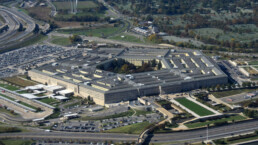The U.S. military economy incorporates hundreds of American communities. Miriam Pemberton’s new book, Six Stops on the National Security Tour, is the first to connect our national security apparatus to the local level via deeply reported portraits of six carefully selected locations, including military Meccas and out-of-the-way places. They are woven into the warfare economy by bases, nuclear weapons labs, and production sites. This is the first of two excerpts Progressive Hub is sharing from her new book’s introduction.
By Miriam Pemberton
The following is an excerpt from Six Stops on the National Security Tour:
Rethinking Warfare Economies (Routledge, 2022). The full text is available from Routledge’s site.
We’ll start the tour at the military’s ground zero, in Washington, DC. Or, specifically, in its Virginia segment across the Potomac. While now and then you drive by military installations in DC and its Maryland suburbs (Walter Reed Army Medical Center, the Naval Surface Warfare Center, the National Defense University for example), you have a hard time avoiding them on the Virginia side of the river.
Begin where the tourists often do, at the Lee Mansion, overlooking Arlington National Cemetery. The military set its footprint here at the start of the Civil War, when General Lee abandoned his wife’s estate and the Union moved in. Following its defeat at Bull Run, the Union army carved the western edge of the estate into a fortification to defend Washington. It’s still there, now as an Army– Marines base called Joint Base Myer-Henderson Hall—270 acres, crooked like a protecting arm around the cemetery.

The process of dislodging this area’s Confederate “heritage” from the landscape has begun. Lee Highway, a major artery that circles around the cemetery from the northwest, retains the name for the time being, but since 2019 its extension down the river no longer carries the name of Jefferson Davis. Between the river and the cemetery at its south end lies the ground zero epicenter itself, the Pentagon.
It too sits on the grounds of the original Lee Estate. Its five concentric rings, linked by 17.5 miles of corridors on the ground and second floors, were built during World War II in concrete, and low to the ground, to conserve steel for ships and weapons. The design carries its own Civil War echoes: Fort Sumter, site of the war’s opening act, is also pentagonal.
Long before 9/11, the building actually acquired the nickname Ground Zero, a nod to its status as the likely target of a nuclear first strike. General Leslie Groves of the Army Corps of Engineers oversaw its construction. In Chapter 6 we’ll visit his other big wartime construction project, in Los Alamos.
At 6.5 million square feet, the Pentagon remains the largest office building in the world. Apart from his dislike of the building’s aesthetics, Franklin Roosevelt’s Uncle Fred Delano—Washington, DC’s chief architectural planner at the time— wondered why such a gargantuan permanent building was needed for a temporary war emergency. (When, a few years later, the War Department became the Department of Defense (DoD), he got his answer.)
Its three above-ground stories sit on two more underground. While patronizing the food court down here, some 26,000 workers in the building (uniformed military, civilian and support personnel) can buy jewelry, a new suit, or chocolate (in the shape of the Hiroshima nuclear bomb, if desired) or get their hair done or their shoes repaired. Or hit the gym, the basketball court or the pool. Or see a dentist. This is all mostly a matter of convenience, removing the midday errand nightmare of navigating massive parking lots and traffic whizzing in all directions around the building. But touring this underground city also conjures an eerie feeling of a separate world where, in the event of a true national security emergency above ground, a lot of the routines of ordinary life could go on undisturbed. Fanning out across town from this spot is an array of military satellite installations—for example, the Defense Advanced Research Projects Agency, the Defense Mapping Agency, the Defense Information Systems Agency, the U.S. Army National Guard Readiness Center and, upriver, the CIA. Up I-95 at Fort Meade, between Washington and Baltimore, is the National Security Agency (NSA), whose five million square feet is second only to the Pentagon.
And, finally, the ground in this area is saturated with defense contractors. The database governmentcontractswon.com lists more than a thousand of them in Arlington County alone, where the Pentagon sits. Since 2000 these Arlington contractors have signed more than 55,000 reported individual military contracts totaling more than $54 billion.
Little manufacturing is done here—the fighter jets get assembled far away from Washington, in places like Texas and California. The bulk of these DC contractors populate sleek, corporate-bland office high-rises, mostly laboring at the white- collar dimensions of the trade—in services such as engineering, logistics, and information technology—and have anodyne names that tell you little about what they do. Take Advanced Systems Development I or, as it now prefers, ASD, which tells you even less. It has ridden the Pentagon’s intensified focus on cybersecurity into contracts with multiple divisions of the Army, the Missile Defense Agency, the million-acre White Sands Missile Range in New Mexico, and the Joint Staff. For many of these companies, the work product consists mostly of interfacing with the Pentagon on behalf of their manufacturing facilities located far away.
Contrary to what we might expect, the area’s military contractors are not most- heavily concentrated in an area next to the Pentagon called Pentagon City—that is dominated by apartments and megamalls. Instead, they have been clustered in a corridor behind Reagan National Airport, called Crystal City. Many of its residential and commercial buildings are connected by underground tunnels, meaning that it’s quite possible to live there without ever going outside.
Here, for example, is Subsystem Technologies, which has done “weapons systems advance engineering analysis” for projects including the most expensive system of all time, the F-35 fighter jet, as well as offering, in its own words, “support in various areas, such as risk analysis, integrated product integrity ana- lysis, vulnerability assessments, penetration testing, security mitigation planning, and security computer-based training; joint capabilities integration,” and the list goes on.
One of Crystal City’s high-rises, at 1235 Clark St., assembles a multitude of contractors, from small branches of Big Five prime contractors General Dynamics and Raytheon, to lesser knowns such as Syncadd Systems (Army, Navy, and Air Force contracts) and Concurrent Technologies, to the Air Force Deputy General Counsel.
Such assemblages, and indeed most of their fellow contractors across town, are invisible to the casual observer driving by. The exception to Pentagon contractor obscurity is the view from the waterfront, where Washington’s warfare economy declares itself, literally, from the rooftops. Gazing across the river from, say, the terrace of the Kennedy Center, it’s hard to miss the neon sign for Raytheon (which, following a merger with United Technologies, is now the second largest military contractor in the world) across the street from BAE Systems, currently number eight. Down the river a sign for the perennial number one, Lockheed Martin, looms over Reagan National Airport. In between are hundreds of other non-behemoths.
This vista is about to acquire a new focal point: the dramatic “Helix” structure announcing Amazon’s new second headquarters. (There will be no sign. Not that one will be needed.) It will push some military contractors toward other parts of the city, while providing amenities like restaurants and trees for the ones that stay. (One architecture critic described the trees running up the sides of the building as “expos[ing] Amazon workers to a cultivated facsimile of what they might find outdoors if they had time to be outdoors.”) Amazon is itself striving mightily to expand its own role as a contractor to its new neighbor. After a protracted challenge to Microsoft’s $10 billion “JEDI” contract to put Pentagon information systems into the cloud, Amazon succeeded in derailing the contract. The procurement process started all over again. And in August of 2021 the National Security Administration announced another contract award to Amazon for cloud services, costing another $10 billion.
Out beyond the Beltway, in every state of the union, and in nearly every congressional district, is the rest of the military’s domestic reach: the missile silos, in places like North Dakota and Missouri, the weapons arsenals in Nevada and Pennsylvania, for example, the vast network of military bases that reaches into every state. And the contractors: In fiscal year 2020 the DoD awarded them more than 3.6 million contracts.
Miriam Pemberton has studied the U.S. military economy and the means of shrinking it down to size for decades, first as Director of the National Commission for Economic Conversion and Disarmament and then as a Research Fellow at the Institute for Policy Studies. With Lawrence Korb, she headed the task force that for a decade produced the annual “Unified Security Budget of the United States.” With William Hartung she edited Lessons from Iraq: Avoiding the Next War (Paradigm, 2008). She headed up the team that produced three successive versions of “Military vs. Climate Security: The Budgets Compared.” Pemberton holds a PhD from the University of Michigan.
Recent Posts
We’re Making ‘Tax the Rich’ More Than a Slogan
December 14, 2025
Take Action Now “Workers Over Billionaires” was the slogan on Labor Day. It should be the slogan every day.By Max Page, Labor Notes Taxing the…
‘Total Amateur Hour’: FBI Official Says Antifa Is #1 Threat in US—But Can’t Say Where, Who, or What It Is
December 13, 2025
Take Action Now “Just a complete admission here that the entire ‘antifa’ threat narrative is totally manufactured by this administration,” said one…
Utah Leaders Are Hindering Efforts To Develop Solar Despite A Goal To Double The State’s Energy Supply
December 12, 2025
Take Action Now Utah Governor Spencer Cox signed bills that will make it more difficult and expensive to develop and produce solar energy, ending tax…
Report of the Independent Democratic Task Force on U.S. Policy Toward Israel
December 12, 2025
Take Action Now For release in connection with the winter meeting of the Democratic National Committee convening on December 11, 2025 in Los Angeles……




